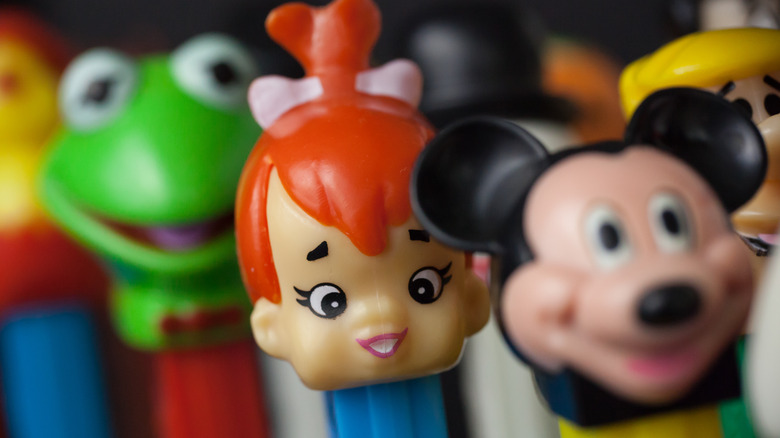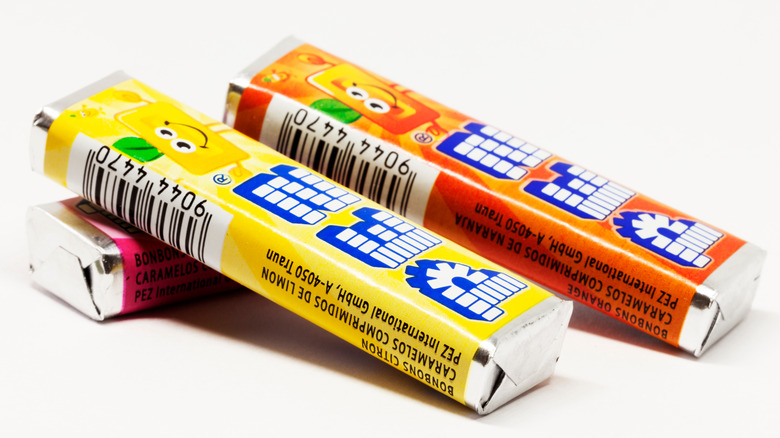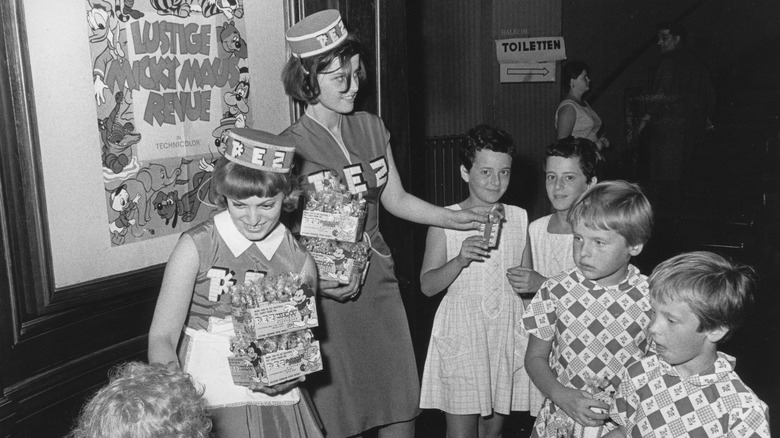The Connection Between Smokers And PEZ Candy
When was the last time you ate some PEZ candy? Perhaps seeing a PEZ dispenser in a checkout aisle today summons memories of elementary school, when you shared those little brick-shaped candy blocks with your friends at lunch. Maybe you even had a dispenser collection in your room when you were a kid, or you have a "vintage" assortment now.
Dozens of characters have been featured on PEZ dispensers over the years. Tinker Bell, Kermit the Frog, pretty much every Disney princess, and various Star Wars characters — the list goes on and on. These likenesses all make it obvious that PEZ is marketed to children (and adults who still love the candy), but did you know children weren't the target audience when the product was first created?
Introduced in 1927 in Austria, PEZ started out as a compressed peppermint candy aimed at individuals who wanted to kick their smoking habit, according to PEZ's History page – in other words, primarily adults. Nearly a century later, the candy has become a nostalgic part of many childhoods and is available all over the United States.
PEZ was once marketed as an alternative to cigarettes
It all started when an 18-year-old business owner named Eduard Haas III, born near Vienna, Austria, created a round peppermint candy in 1927, as Smithsonian Magazine explains. He called them "PEZ Drops," taking the first, middle, and last letters of "pfefferminz," the German word for peppermint, per PEZ. The modern rectangular shape was introduced within the next few years.
Smithsonian Magazine claims Austrians loved Haas' peppermint tablets, which led him to start mass-producing them in the mid-1930s, but by 1947 (if not since the beginning of the endeavor), Haas had another mission in mind. By then, many people had picked up the habit of smoking after World War II, according to Lemelson-MIT, and Haas wanted to help them quit. He saw PEZ Drops as the perfect way to do it, since he figured the oral activity of chewing candy could replace that of smoking while also freshening one's breath.
With this target market shift, he debuted the first official PEZ dispenser in 1949. The original design, pictured in Smithsonian Magazine, mimicked the appearance of a cigarette lighter, only instead of a spark wheel, it featured a contoured flip tip that exposed the vertically stacked candy when opened. And just as with modern dispensers, the very first dispensers held exactly 12 candy tablets, according to the official PEZ website.
Smithsonian Magazine says the ads for the candy, which was marketed as a luxury item for adults, discouraged smoking and encouraged eating PEZ instead with phrases like, "No smoking, PEZing allowed!"
How PEZ shifted from a sophisticated adult item to a fun kids' candy
Before 1950, PEZ candy was only available in Europe, but the company established operations in New York City in 1952, as PEZ explains. Haas faced just one problem, though. Smithsonian Magazine claims Americans weren't really interested in quitting smoking en masse ... yet. In fact, anti-smoking TV ads didn't start airing until 1967, based on data from the National Library of Medicine. This meant Haas had to shift his marketing strategies, and that's when children became the new target audience.
This change led to the introduction of the first 3D, character-inspired dispensers in 1955: a robot and Santa Claus. Other characters and dispenser designs followed in the '50s and '60s, including a space gun (which PEZ says was a failure) and Popeye (its first licensing agreement). According to Lemelson-MIT, the company launched new flavors as well, including lemon, orange, and strawberry, and by 1987, the PEZ website states that "feet" were added to the dispensers to help them stand upright — all innovations that seemingly made the treats-slash-toys easier for kids to handle and more appetizing to eat.
Haas' peppermint candy, originally marketed as an alternative to smoking in Austria, has come a long way since then. Lemelson-MIT highlights that countless cartoon characters and other cultural figures have been adapted into PEZ dispensers since the 1950s, and various celebrities have been known to collect them, including Kourtney Kardashian (via Today). There's even a PEZ convention called Pezamania. Needless to say, people still love their PEZ candy, just like they loved the original PEZ Drops of the 1920s.


